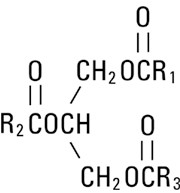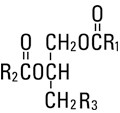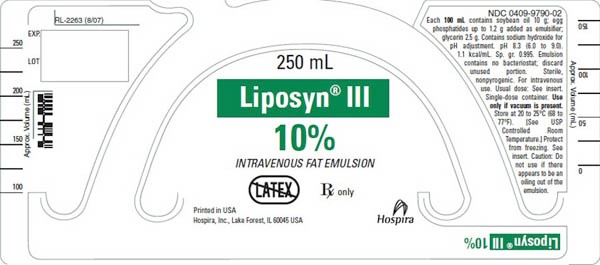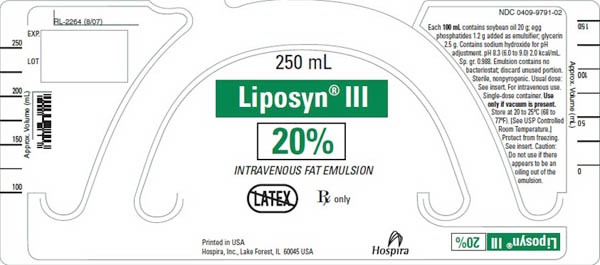Liposyn III
Liposyn III
FULL PRESCRIBING INFORMATION: CONTENTS*
- LIPOSYN III DESCRIPTION
- CLINICAL PHARMACOLOGY
- LIPOSYN III INDICATIONS AND USAGE
- LIPOSYN III CONTRAINDICATIONS
- WARNINGS
- PRECAUTIONS
- LIPOSYN III ADVERSE REACTIONS
- OVERDOSAGE
- LIPOSYN III DOSAGE AND ADMINISTRATION
- HOW SUPPLIED
- References
- RL-2263
- RL-2264
FULL PRESCRIBING INFORMATION
INTRAVENOUS FAT EMULSION
Rx Only
LIPOSYN III DESCRIPTION
Liposyn III (Intravenous Fat Emulsion) is a sterile, nonpyrogenic fat emulsion for intravenous administration. It is supplied in both a 10% and 20% concentration.
Liposyn III 10% contains 10% soybean oil, up to 1.2% egg phosphatides added as an emulsifier and 2.5% glycerin in water for injection. Sodium hydroxide has been added for pH adjustment. pH 8.3 (6.0 to 9.0). Liposyn III 10% has an osmolarity of 284 mOsmol/L (approx.) and a specific gravity of 0.995. The total caloric value of Liposyn III 10% including fat, phospholipid and glycerol is 1.1 kcal/mL. Of this total, approximately 0.5 kcal/mL is supplied by linoleic acid.
Liposyn III 20% contains 20% soybean oil, 1.2% egg phosphatides and 2.5% glycerin in water for injection. Sodium hydroxide has been added for pH adjustment. pH 8.3 (6.0 to 9.0). Liposyn III 20% has an osmolarity of 292 mOsmol/L (approx.) and a specific gravity of 0.988. The total caloric value of Liposyn III 20% including fat, phospholipid and glycerol is 2.0 kcal/mL. Of this total, approximately 1.0 kcal/mL is supplied by linoleic acid.
Both Liposyn III 10% and Liposyn III 20% contain emulsified fat particles of approximately 0.4 micron in diameter, similar to naturally occurring chylomicrons.
Soybean Oil, USP is a mixture of neutral triglycerides with the following structure:

|
|
, |
|
and |
|
| are saturated and unsaturated fatty acid residues. The major component fatty acids are approximately 54.5% linoleic, 22.4% oleic, 10.5% palmitic, 4.2% stearic, and 8.3% linolenic acid. These fatty acids have the following chemical and structural formulas: | ||||
|
Linoleic acid C18H32O2 |
|
|
Oleic acid C18H34O2 |
|
|
Palmitic acid C16H32O2 |
|
|
Stearic acid C18H36O2 |
|
|
Linolenic acid C18H30O2 |
|
Egg phosphatides, purified, are primarily a mixture of naturally occurring phospholipids which are isolated from the egg yolk. These phospholipids have the following general structure:

|
|
|
|
|
are the same saturated and unsaturated fatty acid residues that abound in neutral fats. R3 is primarily either the choline [HOCH2CH2N(CH3)3OH] ester or ethanolamine (HOCH2CH2NH2) ester of phosphoric acid (H3PO4). |
||
Glycerin, USP is chemically designated C3H803 and is a clear, colorless, hygroscopic syrupy liquid. It has the following structural formula:

CLINICAL PHARMACOLOGY
Liposyn III (intravenous fat emulsion) provides the patient requiring parenteral nutrition with a source of calories and the essential fatty acids normally obtained from a nutritionally complete oral diet. The supplemental polyunsaturated fat prevents biochemical changes of essential fatty acid deficiency (EFAD) and prevents and reverses EFAD clinical manifestations (e.g., scaliness of skin, growth retardation, poor wound healing and sparse hair growth).
The infused fat particles are cleared from the bloodstream in a manner thought to be similar to the clearing of chylomicrons. Following infusion, there is a transient increase in plasma triglycerides. The triglycerides are hydrolyzed to free fatty acids and glycerol by the enzyme, lipoprotein lipase. The free fatty acids either enter the tissues (where they may be oxidized or resynthesized into triglycerides and stored) or circulate in the plasma, bound to albumin. In the liver, circulating free fatty acids are oxidized or converted to very low density lipoproteins that re-enter the bloodstream.
Phosphatides are the hydrophobic components of membranes and provide electrically insulated layers. They are involved in the formation of membrane structures. Choline prevents the deposition of fat in the liver.
Glycerol is metabolized to carbon dioxide and glycogen or is used in the synthesis of body fats.
LIPOSYN III INDICATIONS AND USAGE
Liposyn III (intravenous fat emulsion) is indicated as a source of calories for patients requiring parenteral nutrition. Where such nutrition is required for extended periods of time (more than 5 days), Liposyn III is also indicated as a source of essential fatty acids to prevent or reverse biochemical changes in fatty acid composition of plasma lipids (elevated triene/tetraene ratio) and the clinical manifestations of EFAD.
LIPOSYN III CONTRAINDICATIONS
The administration of Liposyn III (intravenous fat emulsion) is contraindicated in patients demonstrating disturbances in normal fat metabolism such as pathologic hyperlipemia, lipoid nephrosis or acute pancreatitis if accompanied by hyperlipemia.
With the exception of heparin at 1 to 2 units/mL of fat emulsion, additives to the Liposyn III bottle are contraindicated.
Partly used containers must not be stored for later use. Filters must not be used with Liposyn III. Do not use any bottle in which there appears to be an oiling out of the emulsion.
WARNINGS
Deaths in preterm infants after infusion of intravenous fat emulsions have been reported in the medical literature.1,2 Autopsy findings included intravascular fat accumulation in the lungs. Treatment of premature and low birth weight infants with intravenous fat emulsion must be based upon careful benefit-risk assessment. Strict adherence to the recommended total daily dose is mandatory; hourly infusion rate should be as slow as possible in each case and should not in any case exceed 1 g/kg in four hours. Premature and small for gestational age infants have poor clearance of intravenous fat emulsion and increased free fatty acid plasma levels following fat emulsion infusion; therefore, serious consideration must be given to administration of less than the maximum recommended doses in these patients in order to decrease the likelihood of intravenous fat overload. The infant’s ability to eliminate infused fat from the circulation must be carefully monitored (such as triglyceride and/or plasma free fatty acid levels). The lipemia must clear between daily infusions.
Caution should be exercised in administering Liposyn III (intravenous fat emulsion) to patients with severe liver damage, pulmonary disease, anemia or blood coagulation disorders or when there is danger of fat embolism. The too rapid administration of Liposyn III can cause fluid and/or fat overloading resulting in dilution of serum electrolyte concentrations, over-hydration, congested states, pulmonary edema, impaired pulmonary diffusion capacity or metabolic acidosis.
WARNING: This product contains aluminum that may be toxic. Aluminum may reach toxic levels with prolonged parenteral administration if kidney function is impaired. Premature neonates are particularly at risk because their kidneys are immature, and they require large amounts of calcium and phosphate solutions, which contain aluminum.
Research indicates that patients with impaired kidney function, including premature neonates, who receive parenteral levels of aluminum at greater than 4 to 5 mcg/kg/day accumulate aluminum at levels associated with central nervous system and bone toxicity. Tissue loading may occur at even lower rates of administration.
PRECAUTIONS
Because free fatty acids displace bilirubin bound to albumin, the use of lipid infusions in jaundiced or premature infants should be undertaken with caution.
During Liposyn III (intravenous fat emulsion) administration, the patient’s hemogram, blood coagulation, liver function, platelet count and plasma lipid profile must be closely monitored. The lipemia must clear between daily infusions. Liposyn III should be discontinued should a significant abnormality in any one of these parameters be attributed to the infusion.
Pregnancy Category C.
Animal reproduction studies have not been conducted with Liposyn III. It is also not known whether Liposyn III can cause fetal harm when administered to a pregnant woman or can affect reproduction capacity. Liposyn III should be given to a pregnant woman only if clearly needed.
Liposyn III is supplied in single-dose containers. Partially used containers must be discarded and should not be stored or resterilized for later use. Do not administer the contents of any container in which the emulsion appears to be oiling out.
This product contains no more than 25 mcg/L of aluminum.
LIPOSYN III ADVERSE REACTIONS
Sepsis due to contamination of administration equipment and thrombophlebitis due to vein irritation from concurrently administered hypertonic solutions have been encountered. These are attributable to I.V. therapy in general or to the type of infusion administered.
Adverse reactions directly related to fat emulsions are of two types: (1) immediate (acute) and (2) long term (chronic). In studies of lipid products in general, the following immediate reactions have been noted: Allergic reactions, hyperlipemia, dyspnea, cyanosis, flushing, dizziness, headache, sleepiness, nausea, vomiting, hyperthermia, sweating, chest and back pain, thrombocytopenia (rarely in neonates), hypercoagulability and transient increases in liver enzymes.
The following reactions have been noted with long-term therapy with lipid infusions in general: Hepatomegaly, jaundice due to central lobular cholestasis, splenomegaly, thrombocytopenia, leucopenia, transient increases in liver function tests, overloading syndrome and the deposition of brown pigment (“fat pigment”) in the reticuloendothelial tissue of the liver. The significance of this last occurrence and its cause are unknown.
OVERDOSAGE
In the event of fat overload during therapy, stop the infusion of Liposyn III until visual inspection of the plasma, determination of triglyceride concentrations, or measurement of plasma light-scattering activity by nephelometry indicates the lipid has cleared. Re-evaluate the patient and institute appropriate corrective measures. See WARNINGS and PRECAUTIONS.
LIPOSYN III DOSAGE AND ADMINISTRATION
Liposyn III (intravenous fat emulsion) should be administered as part of an intravenous total nutrition program via peripheral vein or central venous catheter.
Adult Patients
Liposyn III can provide up to 60% of daily calories at a dose not to exceed 3 g/kg of body weight per day. The other 40% should be provided by carbohydrate and amino acids.
For the prevention of essential fatty acid deficiency, the recommended daily requirement is approximately 4% of the caloric intake as linoleate. In most adult patients, this can be supplied as 500 mL of Liposyn III 10% or 250 mL of Liposyn III 20% administered three times weekly.
The initial infusion rate for the first 15 minutes should be 1.0 mL/minute for Liposyn III 10% and 0.5 mL/minute for Liposyn III 20%. If no adverse effects are observed during this initial infusion, the rate can be increased to allow no more than 500 mL of Liposyn III 10% or 250 mL of Liposyn III 20% to be given over a period of four to six hours.
Pediatric Patients
Liposyn III can provide up to 60% of daily calories at a dose not to exceed 4 g/kg of body weight per day. The other 40% should be provided by carbohydrate and amino acids.
For the prevention of essential fatty acid deficiency, the recommended daily requirement is approximately 4% of the caloric intake as linoleate. The daily dosage of Liposyn III ranges from 7.5 mL to 15 mL per kilogram for the 10% emulsion and 3.8 mL to 7.5 mL per kilogram for the 20% emulsion, depending upon the size and maturity of the patient.
The infusion should be started at a rate of 0.1 mL/minute for the first 15 minutes. If no adverse effects are observed during this initial infusion, the rate can be increased to allow no more than 100 mL of Liposyn III 10% or 50 mL of Liposyn III 20% per hour.
Administration
See CONTRAINDICATIONS regarding mixing this emulsion with other I.V. fluids or additives.
Liposyn III can be infused into the same central or peripheral vein as the carbohydrate/amino acid solutions by means of a short Y-connector near the infusion site. This allows for mixing of the solutions immediately before entering the vein or for alternation of each solution. Flow rates of each solution should be controlled separately by infusion pumps, if these are used. Fat emulsion may also be infused through a separate peripheral site. If desired, heparin may be added to Liposyn III at a concentration of 1 to 2 units per mL prior to administration. Conventional administration sets contain polyvinyl chloride (PVC) components that have DEHP (diethylhexyl phthalate) as a plasticizer. Fat-containing fluids such as Liposyn extract DEHP from this PVC component, and it may be advisable to consider infusion of Liposyn III through a non-DEHP administration set. Filters should not be used for administration of the emulsion. Parenteral drug products should be inspected visually for particulate matter and discoloration prior to administration, whenever solution and container permit.
HOW SUPPLIED
Liposyn III (intravenous fat emulsion) 10% and 20% is a white to slightly off-white emulsion with no evidence of oiling out of the emulsion.
Liposyn III 10% (List No. 9790) is supplied in 200, 250 and 500 mL single-dose containers. Liposyn III 20% (List No. 9791) is supplied in 200, 250 and 500 mL single-dose containers.
Store at 20 to 25°C (68 to 77°F). [See USP Controlled Room Temperature.] Protect from freezing.
References
1. Levene M, Wigglesworth J, Desai R. Pulmonary fat accumulation after Intralipid infusion in the preterm infant.
Lancet II: 815-818, (Oct. 18), 1980.
2. Dahms B, Halpin T. Pulmonary arterial lipid deposit in newborn infants receiving intravenous lipid infusion.
J. Pediatrics: 97:800-805, (Nov.), 1980.
Revised: September, 2005
©Hospira 2005 EN-1013 Printed in USA
Hospira, Inc., Lake Forest, IL 60045 USA
RL-2263

RL-2264

Liposyn IIISOYBEAN OIL, EGG PHOSPHOLIPIDS, and GLYCERIN INJECTION, EMULSION
| ||||||||||||||||||||||||||||||||||||||||||||||||||||||||||||||||||||||||||
Liposyn IIISOYBEAN OIL, EGG PHOSPHOLIPIDS, and GLYCERIN INJECTION, EMULSION
| ||||||||||||||||||||||||||||||||||||||||||||||||||||||||||||||||||||||||||







